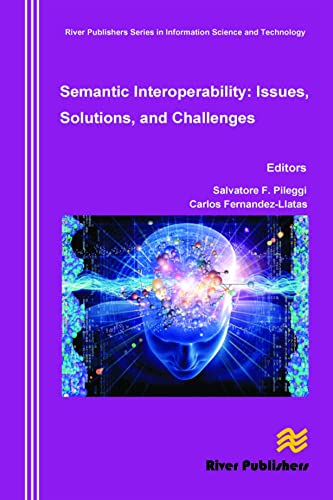Semantic Interoperability Issues, Solutions, Challenges (River Publishers Series in Information Science and Technology) - Hardcover

Inhaltsangabe
Semantic technologies are experimenting an increasing popularity in the context of different domains and applications. The understanding of any class of system can be significantly changed under the assumption any system is part of a global ecosystem known as Semantic Web.The Semantic Web would be an evolving extension of current Web model (normally referred as Syntactic Web) that introduces a semantic layer in which semantics, or meaning of information, are formally defined.So, semantics should integrate web-centric standard information infrastructures improving several aspects of interaction among heterogeneous systems. This is because common interoperability models are progressively becoming obsolete if compared with the intrinsic complexity and always more distributed focus that feature modern systems. For example, the basic interoperability model, that assumes the interchange of messages among systems without any interpretation, is simple but effective only in the context of close environments. Also more advanced models, such as the functional interoperability model that integrates basic interoperability model with the ability of intepretating data context under the assumption of a shared schema for data fields accessing, appears not able to provide a full sustainable technologic support for open systems.The Semantic Interoperability model would improve common interoperability models introducing the interpretation of means of data. Semantic interoperability is a concretely applicable interaction model under the assumption of adopting rich data models (commonly called Ontology) composed of concepts within a domain and the relationships among those concepts.In practice, semantic technologies are partially inverting the common view at actor intelligence: intelligence is not implemented (only) by actors but it is implicitly resident in the knowledge model. In other words, schemas contain information and the "code" to interpretate it.
Die Inhaltsangabe kann sich auf eine andere Ausgabe dieses Titels beziehen.
Über die Autorin bzw. den Autor
Salvatore F. Pileggi, Carlos Fernandez-Llatas
„Über diesen Titel“ kann sich auf eine andere Ausgabe dieses Titels beziehen.
Weitere beliebte Ausgaben desselben Titels
Suchergebnisse für Semantic Interoperability Issues, Solutions, Challenges...
Semantic Interoperability Issues, Solutions, Challenges (River Publishers Series in Information Science and Technology)
Anbieter: Best Price, Torrance, CA, USA
Zustand: New. SUPER FAST SHIPPING. Bestandsnummer des Verkäufers 9788792329790
Semantic Interoperability : Issues, Solutions, Challenges
Anbieter: GreatBookPrices, Columbia, MD, USA
Zustand: New. Bestandsnummer des Verkäufers 17888287-n
Neu kaufen
Anzahl: Mehr als 20 verfügbar
Semantic Interoperability Issues, Solutions, Challenges (River Publishers Series in Information Science and Technology)
Anbieter: Lucky's Textbooks, Dallas, TX, USA
Zustand: New. Bestandsnummer des Verkäufers ABLING22Oct2817100653322
Neu kaufen
Anzahl: Mehr als 20 verfügbar
Semantic Interoperability Issues, Solutions, Challenges
Anbieter: BuchWeltWeit Ludwig Meier e.K., Bergisch Gladbach, Deutschland
Buch. Zustand: Neu. This item is printed on demand - it takes 3-4 days longer - Neuware -Semantic technologies are experimenting an increasing popularity in the context of different domains and applications. The understanding of any class of system can be significantly changed under the assumption any system is part of a global ecosystem known as Semantic Web.The Semantic Web would be an evolving extension of current Web model (normally referred as Syntactic Web) that introduces a semantic layer in which semantics, or meaning of information, are formally defined.So, semantics should integrate web-centric standard information infrastructures improving several aspects of interaction among heterogeneous systems. This is because common interoperability models are progressively becoming obsolete if compared with the intrinsic complexity and always more distributed focus that feature modern systems. For example, the basic interoperability model, that assumes the interchange of messages among systems without any interpretation, is simple but effective only in the context of close environments. Also more advanced models, such as the functional interoperability model that integrates basic interoperability model with the ability of intepretating data context under the assumption of a shared schema for data fields accessing, appears not able to provide a full sustainable technologic support for open systems.The Semantic Interoperability model would improve common interoperability models introducing the interpretation of means of data. Semantic interoperability is a concretely applicable interaction model under the assumption of adopting rich data models (commonly called Ontology) composed of concepts within a domain and the relationships among those concepts.In practice, semantic technologies are partially inverting the common view at actor intelligence: intelligence is not implemented (only) by actors but it is implicitly resident in the knowledge model. In other words, schemas contain information and the 'code' to interpretate it. 162 pp. Englisch. Bestandsnummer des Verkäufers 9788792329790
Neu kaufen
Anzahl: 2 verfügbar
Semantic Interoperability Issues, Solutions, Challenges
Print-on-DemandAnbieter: PBShop.store US, Wood Dale, IL, USA
HRD. Zustand: New. New Book. Shipped from UK. THIS BOOK IS PRINTED ON DEMAND. Established seller since 2000. Bestandsnummer des Verkäufers L1-9788792329790
Neu kaufen
Anzahl: Mehr als 20 verfügbar
Semantic Interoperability Issues, Solutions, Challenges
Print-on-DemandAnbieter: PBShop.store UK, Fairford, GLOS, Vereinigtes Königreich
HRD. Zustand: New. New Book. Delivered from our UK warehouse in 4 to 14 business days. THIS BOOK IS PRINTED ON DEMAND. Established seller since 2000. Bestandsnummer des Verkäufers L1-9788792329790
Neu kaufen
Anzahl: Mehr als 20 verfügbar
Semantic Interoperability : Issues, Solutions, Challenges
Anbieter: GreatBookPricesUK, Woodford Green, Vereinigtes Königreich
Zustand: New. Bestandsnummer des Verkäufers 17888287-n
Neu kaufen
Anzahl: Mehr als 20 verfügbar
Semantic Interoperability Issues, Solutions, Challenges (River Publishers Series in Information Science and Technology)
Anbieter: Ria Christie Collections, Uxbridge, Vereinigtes Königreich
Zustand: New. In. Bestandsnummer des Verkäufers ria9788792329790_new
Neu kaufen
Anzahl: Mehr als 20 verfügbar
Semantic Interoperability : Issues, Solutions, Challenges
Anbieter: GreatBookPricesUK, Woodford Green, Vereinigtes Königreich
Zustand: As New. Unread book in perfect condition. Bestandsnummer des Verkäufers 17888287
Gebraucht kaufen
Anzahl: Mehr als 20 verfügbar
Semantic Interoperability- Issues, Solutions, and Challenges (River Publishers Series in Information Science and Technology)
Anbieter: Mispah books, Redhill, SURRE, Vereinigtes Königreich
Hardcover. Zustand: Like New. Like New. book. Bestandsnummer des Verkäufers ERICA77387923297996
Gebraucht kaufen
Anzahl: 1 verfügbar

